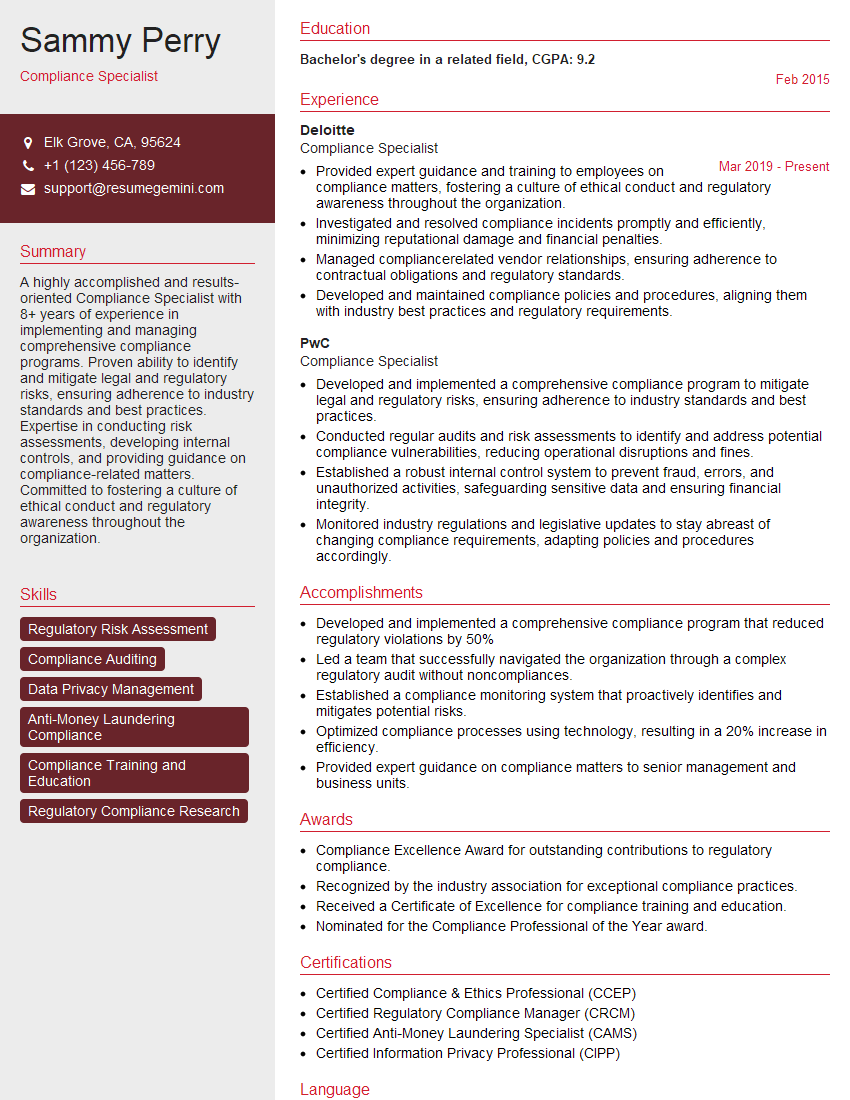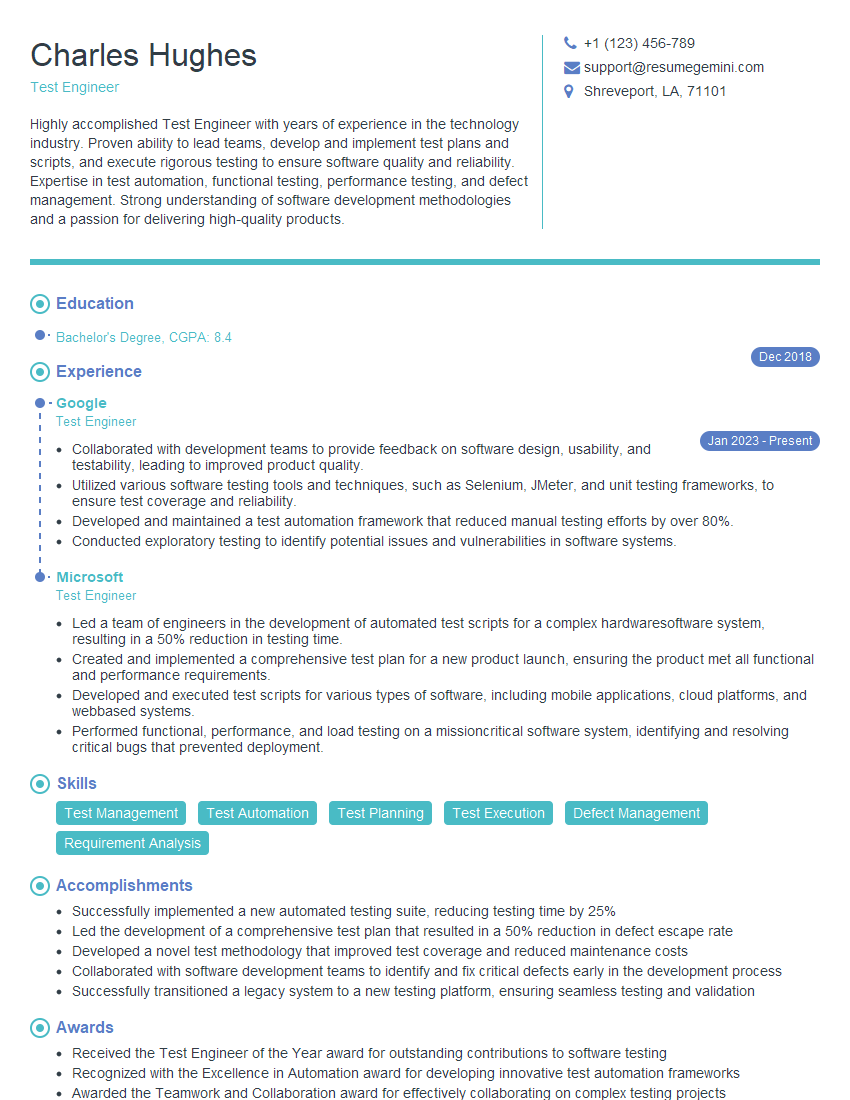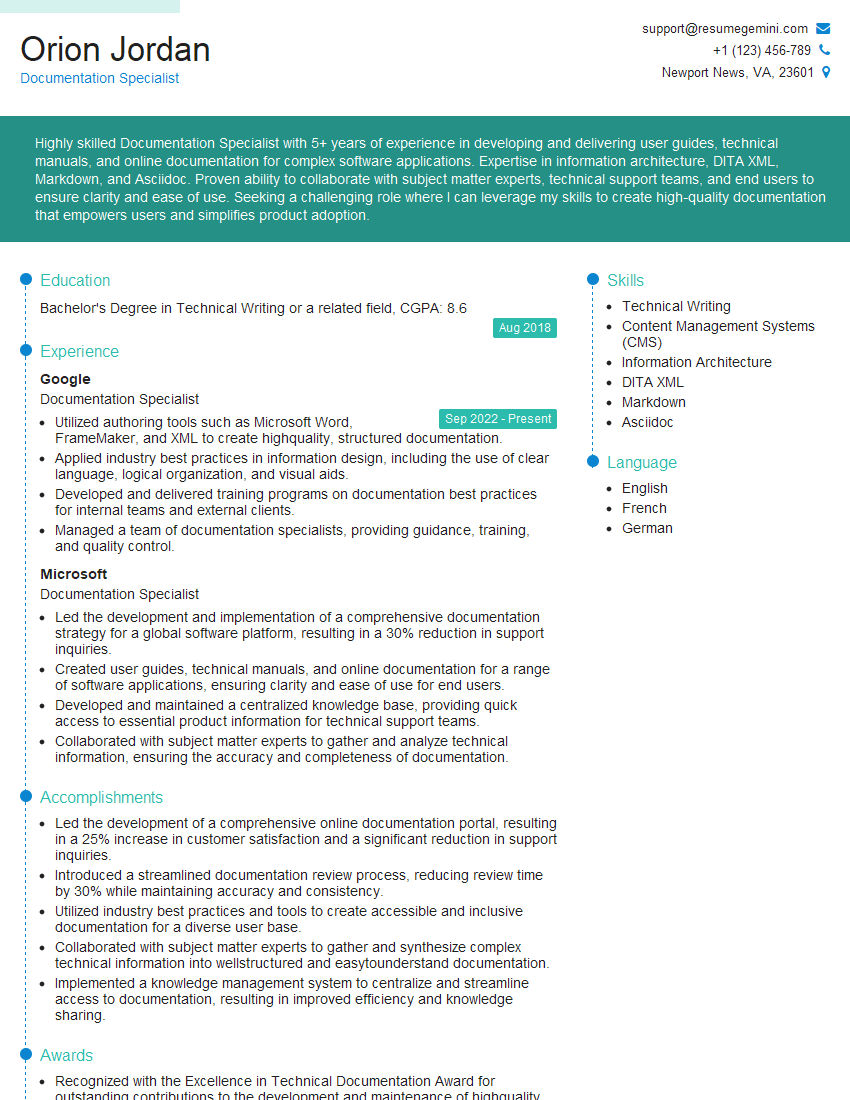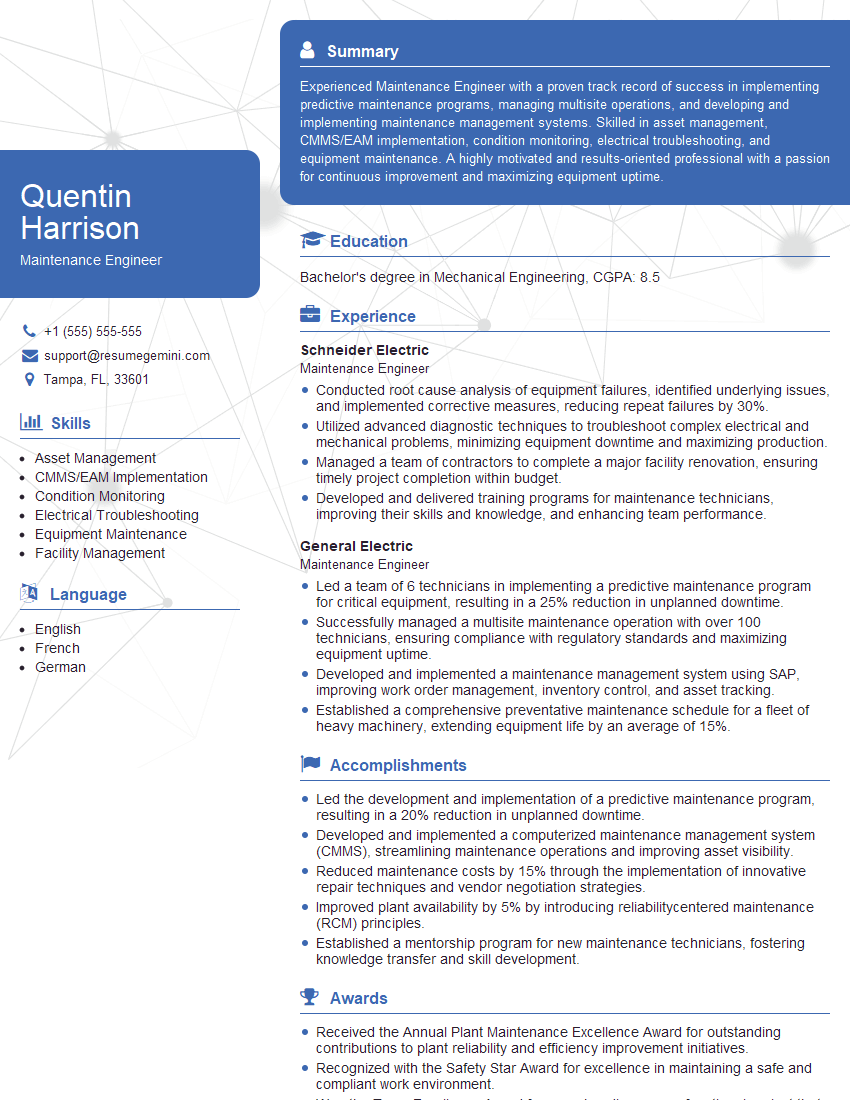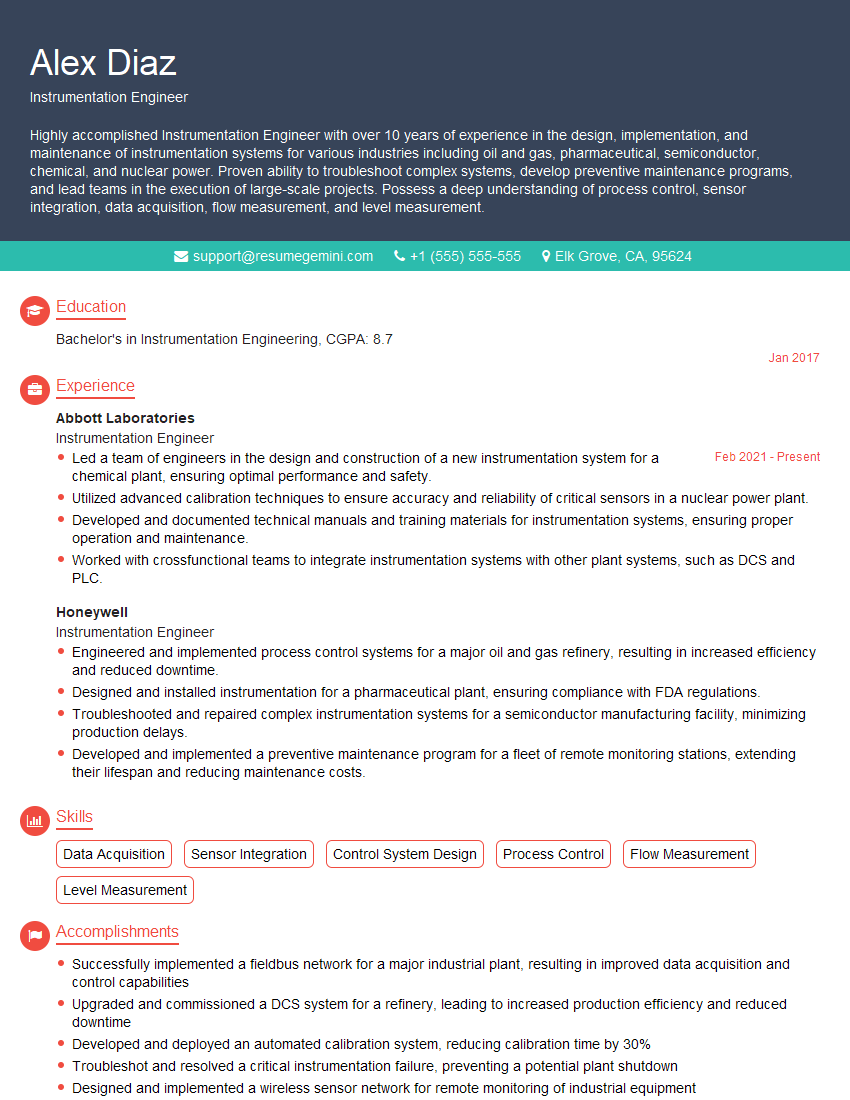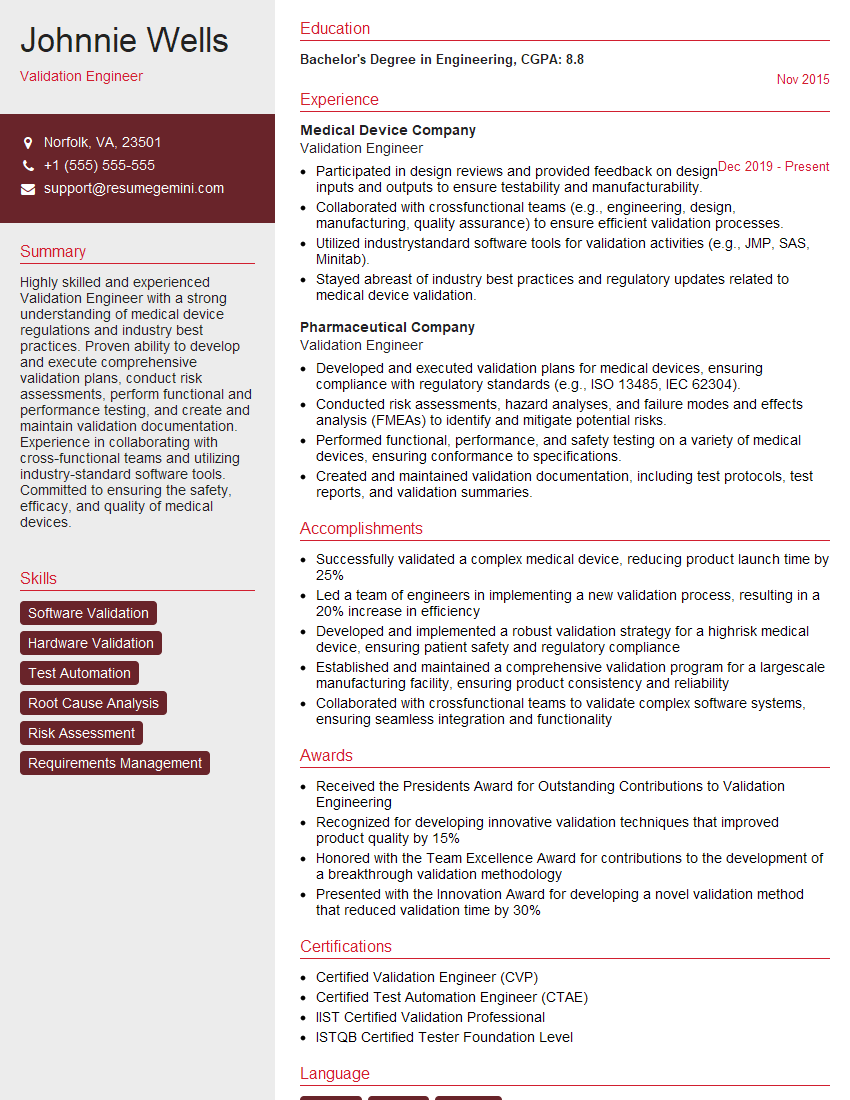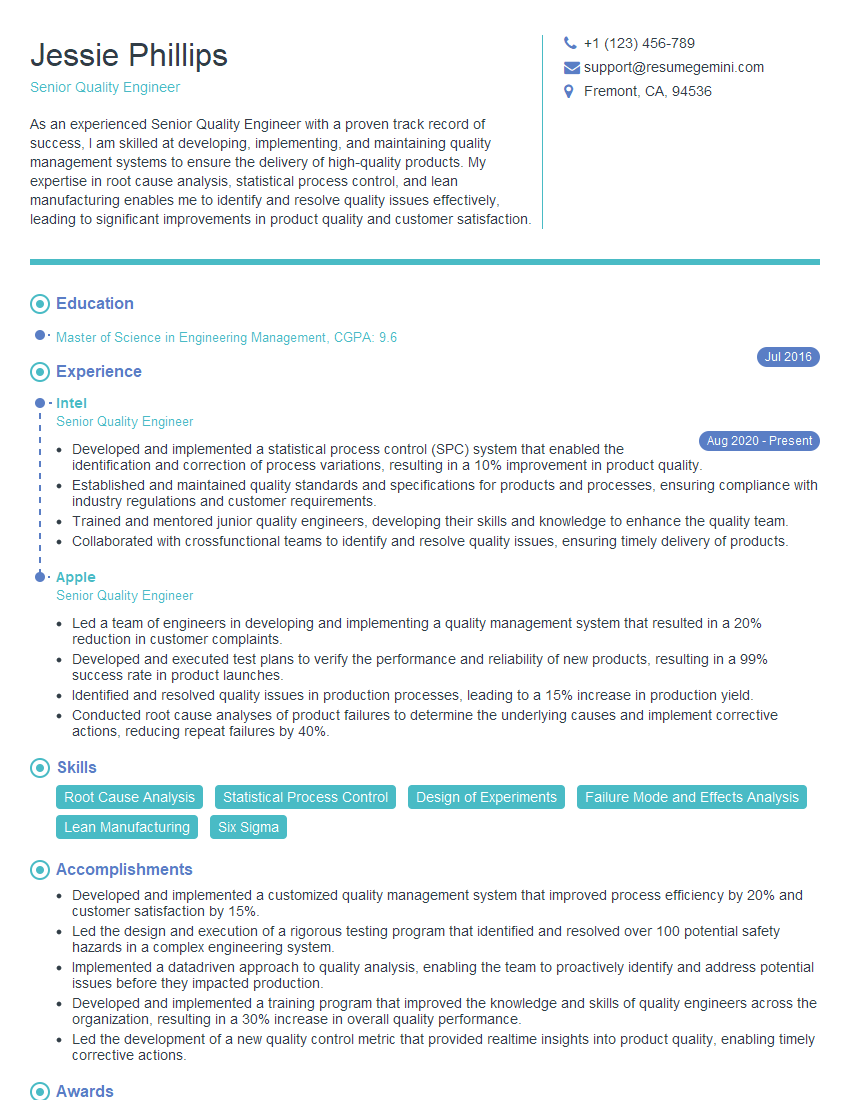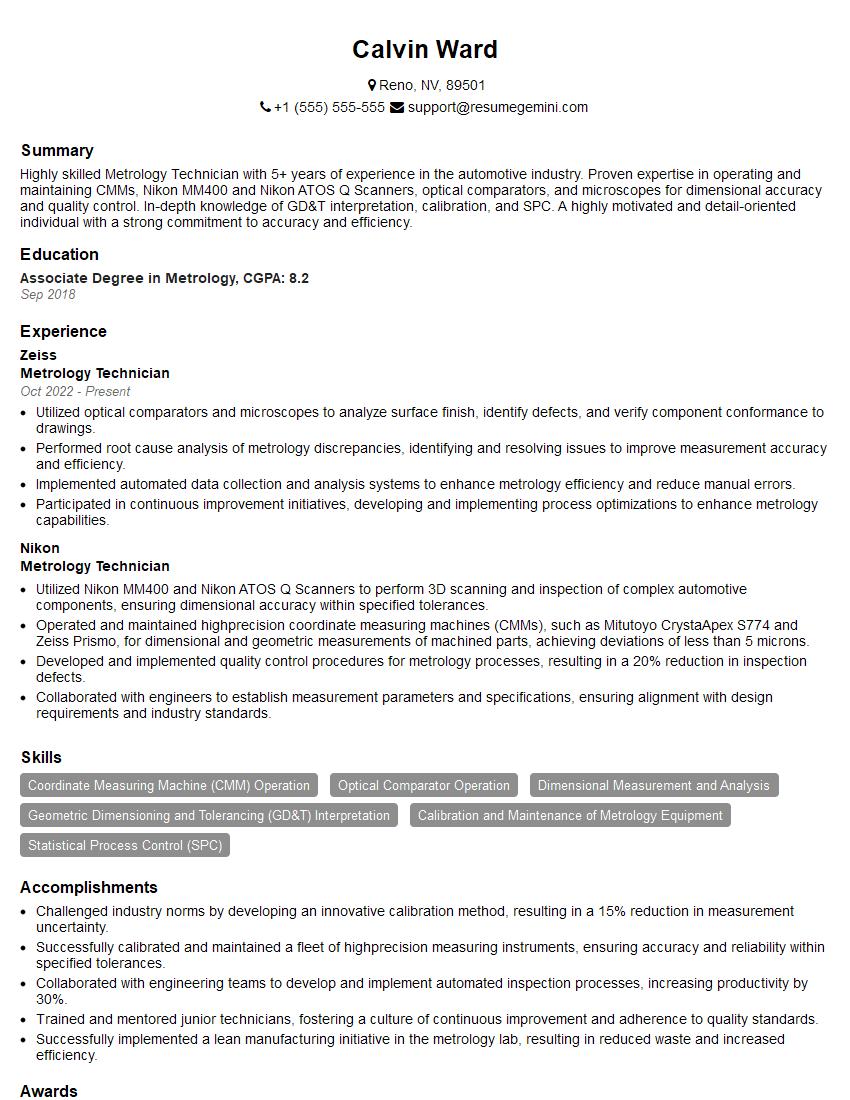Feeling uncertain about what to expect in your upcoming interview? We’ve got you covered! This blog highlights the most important Calibration Procedure Writing interview questions and provides actionable advice to help you stand out as the ideal candidate. Let’s pave the way for your success.
Questions Asked in Calibration Procedure Writing Interview
Q 1. Explain the importance of a well-defined calibration procedure.
A well-defined calibration procedure is the cornerstone of accurate and reliable measurement. It ensures that instruments used in any process – from manufacturing to scientific research – provide consistent and trustworthy results. Without a clear procedure, measurements can be inaccurate, leading to costly errors, compromised product quality, and even safety hazards. Think of it like a recipe: a precise recipe guarantees a consistent cake; a poorly defined one might lead to disaster!
For instance, imagine a lab using a balance to weigh chemicals for an experiment. Without a meticulously documented calibration procedure, the balance’s accuracy cannot be guaranteed, potentially affecting the experiment’s outcome and reproducibility. A well-defined procedure removes this ambiguity and ensures confidence in the results.
Q 2. Describe the different types of calibration methods you are familiar with.
Calibration methods vary depending on the instrument and its application. I’m familiar with several, including:
- Direct comparison: This involves comparing the instrument’s reading to a known standard (e.g., comparing a thermometer to a calibrated reference thermometer). This is straightforward and often used for simpler instruments.
- Substitution method: The instrument under test is replaced with a known standard, and the difference in readings is used to determine the correction factor.
- Calibration using a known standard: A reference standard with a certified accuracy is used to check the accuracy of the instrument being calibrated.
- Comparison calibration: This involves comparing two or more instruments measuring the same quantity. Any deviation indicates the error in the tested instruments.
- Functional calibration: This involves calibrating the instrument by testing its response to several known inputs (e.g., for a pressure gauge, applying several known pressures and noting the readings).
The choice of method depends on factors like the instrument’s complexity, required accuracy, and available resources.
Q 3. What are the key elements of a comprehensive calibration procedure?
A comprehensive calibration procedure should include these key elements:
- Purpose and Scope: Clearly state the instrument being calibrated, its purpose, and the range of measurements it covers.
- References: List any relevant standards, specifications, or guidelines that apply.
- Equipment and Materials: Specify all necessary equipment, standards, tools, and materials.
- Procedure: Provide a step-by-step guide on how to perform the calibration, including setup, measurements, and calculations.
- Acceptance Criteria: Define the tolerance limits – the acceptable range of error for the instrument.
- Calibration Data Sheet: A template for recording all relevant data, including readings, calculations, and adjustments.
- Corrective Action: Outline the steps to take if the instrument fails to meet acceptance criteria.
- Certification and Approval: Processes for approving the calibration report and signing off.
A well-documented procedure ensures consistency and reproducibility, making it easier to track changes over time and minimize errors.
Q 4. How do you ensure traceability in calibration procedures?
Traceability is crucial for ensuring the reliability of calibration results. It means establishing an unbroken chain of comparisons from the instrument being calibrated all the way back to national or international standards. Think of it as a family tree for your measurements, ensuring they have a verifiable lineage. This is typically achieved by using calibration standards that have been themselves calibrated by a recognized calibration laboratory with documented traceability to national standards (like NIST in the US or NPL in the UK).
For example, if you calibrate a pressure gauge, your standard should be traceable to a primary standard maintained by a national metrology institute. The calibration certificate for your standard should clearly show this traceability chain. This documentation is essential for audits and regulatory compliance.
Q 5. Explain the concept of calibration uncertainty and its significance.
Calibration uncertainty quantifies the doubt associated with a measurement result. It represents the range of values within which the true value is likely to lie. A smaller uncertainty indicates greater confidence in the measurement. It’s important because it helps determine the reliability of measurement results and allows for informed decision-making.
For instance, if a thermometer reads 25°C with an uncertainty of ±0.5°C, it means the true temperature is likely between 24.5°C and 25.5°C. This uncertainty needs to be considered when making decisions based on this temperature reading. Ignoring uncertainty can lead to inaccurate conclusions and potentially serious consequences.
Q 6. How do you determine the appropriate calibration interval for an instrument?
Determining the appropriate calibration interval is crucial for maintaining instrument accuracy and requires careful consideration. Several factors are taken into account:
- Instrument type and use: A frequently used instrument in a harsh environment will require more frequent calibration than one used infrequently in a controlled environment.
- Manufacturer’s recommendations: The manufacturer often provides guidelines on the recommended calibration interval.
- Past calibration history: The stability of the instrument over time, as indicated by past calibration data, can inform the interval.
- Criticality of measurements: Instruments used for critical measurements, where inaccuracies can have serious consequences, should be calibrated more frequently.
- Regulatory requirements: Some industries have regulatory requirements mandating specific calibration intervals.
Often, a risk assessment is performed to determine the optimal calibration interval balancing cost and risk. For example, a high precision analytical balance in a pharmaceutical lab would warrant significantly more frequent calibration than a basic bench scale in a less critical setting.
Q 7. Describe your experience with different calibration software and systems.
Throughout my career, I’ve worked with a variety of calibration software and systems, both proprietary and open-source. I’m proficient in using software designed for specific instrument types (e.g., those used for calibrating electronic balances, pressure gauges, and temperature sensors). These often include features for data logging, report generation, and traceability management. I have also worked extensively with LIMS (Laboratory Information Management Systems) that integrate calibration management into the overall workflow. This experience allows me to effectively manage the calibration process, ensuring data integrity and compliance. I’m also comfortable working with databases to store and analyze calibration data, allowing for trend analysis and predictive maintenance strategies.
My experience extends to understanding the importance of data security and implementing measures to protect sensitive calibration information within these systems. I am familiar with systems that allow for secure data access and audit trails, crucial for maintaining data integrity and regulatory compliance.
Q 8. How do you handle calibration discrepancies and out-of-tolerance results?
Handling calibration discrepancies and out-of-tolerance results requires a systematic approach. First, we must verify the discrepancy. Was there an error in the procedure, a problem with the equipment used for calibration, or an issue with the instrument being calibrated? A thorough investigation is crucial. This might involve re-calibrating the instrument, checking the calibration equipment’s own certification, and reviewing the calibration procedure for any flaws.
If the discrepancy is confirmed, we then determine the root cause. Was it a simple operator error, a need for maintenance or repair of the instrument, or perhaps a degradation in the instrument’s performance over time? Proper documentation is key. We meticulously record all findings, corrective actions taken, and any adjustments made.
Depending on the severity of the out-of-tolerance result, we might need to initiate a corrective and preventative action (CAPA) process. This involves implementing steps to prevent similar issues in the future. This could be as simple as updated training for operators or as complex as a review and revision of the entire calibration process. Ultimately, the goal is to ensure the accuracy and reliability of our measurements.
For example, if a temperature sensor consistently reads 2°C lower than the reference standard, we might need to adjust the sensor’s offset, repair a faulty component, or even replace the sensor altogether. The entire process, from initial discovery to corrective action, is documented meticulously and reviewed by a supervisor.
Q 9. Explain your process for documenting calibration procedures.
My process for documenting calibration procedures emphasizes clarity, completeness, and traceability. We use a standardized template, ensuring consistency across all procedures. The template includes sections for:
- Procedure Title and Revision Number: Clearly identifying the procedure and its version.
- Scope and Purpose: Defining the instruments and parameters covered.
- Equipment Required: Listing all necessary equipment, including their calibration status.
- Safety Precautions: Highlighting potential hazards and safety measures.
- Step-by-Step Procedure: Providing clear and concise instructions with diagrams when necessary.
- Acceptance Criteria: Defining acceptable tolerances and limits.
- Data Recording: Specifying the data to be recorded and how it should be presented.
- Calculations (if applicable): Showing any necessary calculations.
- Approvals and Signatures: Including spaces for author, reviewer, and approver signatures.
We maintain a version control system to track changes and ensure everyone uses the latest version. This is essential for ensuring traceability and maintaining the integrity of our calibration data. Think of it as a recipe – following it precisely ensures consistent results.
Q 10. How do you ensure the accuracy and reliability of calibration data?
Ensuring the accuracy and reliability of calibration data hinges on several key factors. First, using calibrated reference standards is paramount. These standards must be traceable to national or international standards. Second, using appropriately calibrated equipment for calibration is essential. This creates a chain of traceability, ensuring the accuracy of our measurements.
We also employ rigorous quality control measures, including regular checks of the calibration equipment, adherence to standard operating procedures, and training of personnel. We validate our calibration methods periodically to ensure they remain accurate and reliable. Data is checked for any anomalies or outliers, and any deviations are investigated and documented.
Statistical process control (SPC) techniques are employed to monitor the calibration process and identify any trends or patterns that may indicate problems. Regular audits and internal reviews help identify areas for improvement. By employing these methods, we strive to minimize uncertainty and maintain confidence in the integrity of our calibration data.
Q 11. Describe your experience with ISO 17025 and its impact on calibration procedures.
ISO 17025 is a globally recognized standard for testing and calibration laboratories. My experience with this standard has profoundly impacted my approach to calibration procedures. It emphasizes the importance of documented quality management systems, ensuring traceability of calibration data, and competence of personnel.
Under ISO 17025, calibration procedures must be detailed, comprehensive, and reviewed regularly. Traceability to national or international standards is essential, requiring a documented chain of custody for all reference standards used. Personnel competency is verified through training and documented assessments. The standard demands rigorous record-keeping and a systematic approach to handling non-conformances, ensuring quality and reliability. Adherence to ISO 17025 provides a framework for building confidence in our calibration results and demonstrating our competence to our clients.
Q 12. How do you manage and maintain calibration records?
Calibration records are managed using a dedicated database system. This allows for efficient searching, retrieval, and reporting of calibration data. Each record includes complete information about the calibrated instrument, the calibration procedure used, the date of calibration, results, and any corrective actions taken. The system ensures data integrity and facilitates easy traceability.
Records are securely stored both electronically and in hard copy, complying with data retention policies. We use a robust system of access control to ensure only authorized personnel can access and modify the records. Regular backups are performed to prevent data loss. The system also generates reports, which are used for auditing and for demonstrating compliance with regulatory requirements.
Q 13. What is your experience with different types of calibration equipment?
My experience spans a wide range of calibration equipment, including:
- Temperature: Thermocouples, RTDs, thermometers, temperature baths, and ovens.
- Pressure: Pressure gauges, transducers, and manometers.
- Mass: Balances and weights.
- Electrical: Multimeters, oscilloscopes, power meters, and current sources.
- Dimensional: Micrometers, calipers, and height gauges.
I’m proficient in using various calibration techniques and understanding the specific requirements for each type of equipment. This involves selecting appropriate reference standards, utilizing correct calibration procedures, and accurately interpreting the results.
Q 14. Explain your experience with statistical process control (SPC) in calibration.
Statistical Process Control (SPC) plays a vital role in ensuring the ongoing accuracy and reliability of our calibration processes. We use control charts, such as X-bar and R charts, to monitor key calibration parameters over time. This allows us to identify any trends or shifts in the data that might indicate a problem with the calibration equipment, the calibration procedure, or even the environment in which the calibrations are performed.
By continuously monitoring these parameters, we can detect potential issues early on, preventing them from impacting the accuracy of our measurements. For instance, if the control chart shows a consistent drift in the readings of a specific instrument, we’ll investigate the root cause and take corrective action. This proactive approach ensures that our calibration processes remain robust and reliable over time. The data from SPC analysis is also used to help justify the calibration intervals for our instruments.
Q 15. How do you validate a new calibration procedure?
Validating a new calibration procedure ensures it’s accurate, reliable, and meets the required standards. This involves a multi-step process. Think of it like testing a new recipe before serving it to guests – you wouldn’t want to serve something that doesn’t work!
- Comparative Testing: We compare the results obtained using the new procedure against a known, validated method or a reference standard. This verifies the accuracy and precision of the new method.
- Repeatability and Reproducibility Studies: We conduct multiple calibrations by different technicians using the new procedure to assess its repeatability (consistency within the same technician and equipment) and reproducibility (consistency across different technicians and equipment). This ensures consistent results regardless of who performs the calibration.
- Uncertainty Analysis: We quantify the uncertainty associated with the measurements obtained using the new procedure. This helps determine the reliability of the results and ensures the procedure meets the required tolerances.
- Documentation Review: The procedure itself is thoroughly reviewed for clarity, completeness, and compliance with relevant standards (e.g., ISO 17025). We make sure it’s easy for anyone to follow and understand.
- Approval Process: Finally, the validation report, summarizing all findings, is reviewed and approved by designated personnel with appropriate authority.
For example, if we’re validating a new procedure for calibrating pressure gauges, we might compare its results against a traceable pressure standard. If the differences fall within an acceptable tolerance, the new procedure is deemed validated.
Career Expert Tips:
- Ace those interviews! Prepare effectively by reviewing the Top 50 Most Common Interview Questions on ResumeGemini.
- Navigate your job search with confidence! Explore a wide range of Career Tips on ResumeGemini. Learn about common challenges and recommendations to overcome them.
- Craft the perfect resume! Master the Art of Resume Writing with ResumeGemini’s guide. Showcase your unique qualifications and achievements effectively.
- Don’t miss out on holiday savings! Build your dream resume with ResumeGemini’s ATS optimized templates.
Q 16. How do you handle non-conforming calibration results?
Handling non-conforming calibration results requires a systematic approach to identify the root cause, correct the situation, and prevent recurrence. Imagine finding a faulty component in a sophisticated machine – you wouldn’t just ignore it!
- Investigation: We initiate an investigation to determine the reason for the non-conformance. This may involve reviewing calibration records, inspecting equipment, and interviewing personnel.
- Corrective Actions: Based on the investigation, we implement corrective actions to address the root cause. This could involve repairing or replacing faulty equipment, retraining personnel, or revising the calibration procedure itself.
- Re-calibration: Once corrective actions are implemented, the equipment is re-calibrated to ensure it meets the required specifications. This confirms that the problem has been resolved.
- Documentation: All actions taken, including the investigation, corrective actions, and re-calibration results, are meticulously documented. This forms a clear audit trail and helps prevent future occurrences.
- Reporting: We communicate the non-conformance, corrective actions, and re-calibration results to relevant stakeholders, including management and clients.
For instance, if a thermometer consistently reads low, we might investigate whether it needs recalibration, its probe is damaged, or the technician made an error in reading the instrument. The corrective action would address the identified problem.
Q 17. Describe your experience with root cause analysis for calibration failures.
Root cause analysis (RCA) for calibration failures is crucial for preventing future issues. It’s like detective work, uncovering the underlying reasons for a problem instead of just treating the symptoms.
I typically employ methodologies like the 5 Whys, Fishbone diagrams (Ishikawa diagrams), and Fault Tree Analysis to identify the root causes.
- 5 Whys: This iterative technique involves repeatedly asking “Why?” to uncover the underlying reasons behind a failure. For example: Why did the calibration fail? Because the equipment was faulty. Why was the equipment faulty? Because it wasn’t properly maintained. Why wasn’t it maintained? Because the maintenance schedule wasn’t followed. And so on…
- Fishbone Diagram: This visual tool helps to brainstorm and organize potential causes categorized by factors like equipment, personnel, environment, and materials. It provides a structured way to explore different possibilities.
- Fault Tree Analysis: This more advanced technique uses a logic diagram to illustrate the combinations of events that can lead to a particular failure. It’s especially useful for complex systems.
After identifying the root cause, corrective actions are implemented and documented, ensuring that similar failures are prevented in the future. The key is not only fixing the immediate problem but also preventing it from happening again.
Q 18. How do you ensure the proper training of personnel involved in calibration?
Proper training is essential for accurate and reliable calibrations. It’s like teaching a chef to follow a recipe correctly – if they don’t understand the process, the outcome will suffer.
- Initial Training: We provide comprehensive initial training on calibration procedures, equipment operation, safety protocols, and relevant standards (like ISO 17025).
- On-the-Job Training: Experienced calibrators mentor new personnel, providing hands-on training and guidance.
- Refresher Training: Regular refresher training is provided to maintain competence and update personnel on any changes in procedures or standards.
- Competency Assessment: We assess the competency of personnel through practical tests and evaluations to ensure they can perform calibrations accurately and reliably.
- Documentation: Training records, including attendance, assessment results, and any corrective actions, are meticulously documented.
The training program includes both theoretical knowledge and practical exercises. We use a combination of classroom instruction, demonstrations, and hands-on practice to ensure personnel develop the necessary skills and understanding.
Q 19. How do you communicate calibration results effectively to stakeholders?
Effective communication of calibration results is critical for maintaining confidence in the accuracy of measurements. Think of it like providing a clear report card to stakeholders showing the performance of the equipment – everyone needs to understand it.
- Clear and Concise Reports: Calibration reports are clear, concise, and easy to understand, avoiding technical jargon whenever possible.
- Appropriate Format: The format of the reports is consistent and adheres to established standards.
- Timely Delivery: Reports are delivered to stakeholders in a timely manner.
- Appropriate Medium: We use appropriate communication channels, such as email, internal systems, or direct meetings, depending on the audience and the urgency of the information.
- Follow-up: We follow up on any queries or concerns related to calibration results.
For example, a simple, well-structured table summarizing the calibration results, including the measured value, uncertainty, and pass/fail status, is more effective than a long narrative report. Using visual aids like graphs can be helpful in conveying complex information clearly.
Q 20. Explain your experience with different calibration standards and guidelines.
My experience encompasses a broad range of calibration standards and guidelines, including but not limited to ISO 17025, NIST guidelines, and industry-specific standards. These provide a framework for ensuring the quality and reliability of calibration processes. Each standard has its specific requirements and recommendations.
- ISO 17025: This international standard specifies the general requirements for the competence of testing and calibration laboratories. It focuses on the management system, technical competence, and quality control aspects of calibration activities.
- NIST Guidelines: The National Institute of Standards and Technology (NIST) provides guidelines and traceability standards that are widely used in the United States for various types of measurements. They offer comprehensive guidance on measurement uncertainty and calibration procedures.
- Industry-Specific Standards: Many industries have their own standards and guidelines for calibration, often based on ISO 17025 or other national/international standards. These standards specify calibration requirements specific to the particular industry.
Understanding and applying these standards correctly is critical for ensuring accurate and reliable calibration results. The specific requirements will vary depending on the type of equipment being calibrated and the industry involved. We always work within the appropriate standards for the job.
Q 21. Describe your experience with auditing calibration procedures.
Auditing calibration procedures is a critical component of maintaining a quality management system. It’s like a health check for the entire calibration process – ensuring everything is working as it should.
- Compliance Review: We review the calibration procedures for compliance with relevant standards (e.g., ISO 17025), company policies, and legal requirements.
- Record Review: We examine the calibration records for completeness, accuracy, and traceability.
- Equipment Evaluation: We assess the calibration equipment for proper maintenance, calibration status, and suitability for its intended purpose.
- Personnel Competency Check: We verify the competence of the personnel performing calibrations through reviewing training records and observation of calibration practices.
- Procedure Effectiveness Evaluation: We assess the effectiveness of the calibration procedures by reviewing the data generated and identifying areas for improvement.
The audit involves checking both the documentation (procedures, records) and the actual calibration practices. We might conduct a sample audit of calibration records, observe technicians performing calibrations, and interview key personnel involved in the process. The goal is to identify weaknesses and ensure continuous improvement in the calibration process.
Q 22. How do you stay up-to-date with the latest developments in calibration technology?
Staying current in the dynamic field of calibration technology requires a multi-pronged approach. I actively participate in professional organizations like the American Society for Quality (ASQ) and attend industry conferences and webinars to learn about new methodologies, instruments, and best practices. These events often feature presentations from leading experts and offer valuable networking opportunities. Furthermore, I subscribe to relevant journals and industry publications, such as those published by NIST (National Institute of Standards and Technology), which provide in-depth analysis and research on calibration advancements. Finally, I regularly review and update my knowledge base using online resources, such as manufacturer websites and reputable technical blogs, ensuring I’m familiar with the latest software updates and instrument capabilities.
Q 23. How do you prioritize different calibration tasks based on urgency and importance?
Prioritizing calibration tasks effectively involves a structured approach that balances urgency and importance. I typically utilize a matrix system where tasks are ranked based on two key factors: risk and impact. High-risk, high-impact tasks, such as calibrating safety-critical equipment in a manufacturing plant, naturally take precedence. I use a combination of factors to assess risk, including the potential for equipment failure, safety hazards, and financial consequences of inaccurate measurements. Impact assesses the consequences of a delay or failure in calibration. A simple visual tool, like a matrix chart, can clearly display these priorities. This allows for efficient resource allocation and minimizes potential downtime or safety risks. Regular review and adjustment of this matrix is crucial, as priorities may shift due to changes in operational needs or regulatory requirements.
Q 24. Describe a challenging calibration situation you faced and how you resolved it.
In a previous role, we encountered a situation where a highly specialized pressure transducer used in a pharmaceutical manufacturing process started providing erratic readings. Initial troubleshooting suggested a malfunction, but replacing the instrument proved prohibitively expensive and time-consuming. We faced significant pressure to restore accurate measurements quickly. Instead of immediately replacing the transducer, I systematically investigated the entire calibration chain. We checked the reference standard’s traceability, examined the calibration procedures, and meticulously inspected the instrument’s connections and environment for potential interference. We discovered a previously unnoticed environmental factor — significant temperature fluctuations — affecting the transducer’s performance. By implementing temperature control measures and carefully documenting the temperature’s impact on the readings through additional calibration points, we were able to compensate for the environmental variability. This proactive approach resolved the issue without the need for expensive replacements, minimizing downtime and maintaining compliance.
Q 25. Explain your experience with different types of calibration instruments (e.g., pressure gauges, thermometers).
My experience encompasses a wide range of calibration instruments. I’m proficient in calibrating various types of pressure gauges, including Bourdon tube, diaphragm, and digital pressure gauges, across different pressure ranges and accuracy classes. I have extensive experience with different thermometer types: mercury-in-glass, resistance temperature detectors (RTDs), thermocouples, and infrared thermometers. The procedures for calibrating each instrument differ depending on its design and measurement principle, requiring a thorough understanding of the relevant metrological standards and best practices. For instance, calibrating a pressure gauge involves comparing its readings against a traceable reference standard, while thermometer calibration involves immersion techniques or comparison with a calibrated reference bath. Each process necessitates careful attention to detail, accurate record-keeping, and understanding of potential error sources.
Q 26. How do you ensure the security and integrity of calibration data?
Ensuring the security and integrity of calibration data is paramount. We implement robust data management systems that incorporate several layers of security. Calibration data is stored in a secure, auditable database with access control restrictions, limiting access only to authorized personnel. A robust version control system prevents accidental data overwriting and maintains a complete history of revisions. Furthermore, data integrity is maintained through rigorous procedures for data entry, verification, and validation. Regular data backups are performed and stored offsite to ensure data recovery in case of system failures or disasters. We also implement digital signatures and encryption where appropriate to ensure data authenticity and confidentiality. Finally, compliance with relevant regulatory standards, such as ISO 17025, is strictly enforced to guarantee the traceability and reliability of the calibration data.
Q 27. How do you adapt calibration procedures to meet specific customer requirements?
Adapting calibration procedures to meet specific customer requirements is a crucial aspect of providing customized and effective calibration services. We engage in thorough pre-calibration discussions to understand the customer’s unique needs, including the type of equipment, its application, required accuracy, relevant standards, and any specific operational conditions. Once these needs are clearly defined, we tailor the calibration procedure accordingly. This may involve modifying the calibration methodology, using specific reference standards, extending the calibration range, or documenting additional parameters. For instance, if a customer requires calibration to meet a specific industry standard, such as FDA requirements for pharmaceutical manufacturing, we modify our procedures to align with those guidelines. All deviations from our standard procedures are carefully documented and approved, ensuring traceability and compliance. Post-calibration, a comprehensive report is generated that clearly outlines the performed procedure and its alignment with the customer’s requirements.
Key Topics to Learn for Calibration Procedure Writing Interview
- Understanding Calibration Principles: Grasping the fundamental concepts of accuracy, precision, traceability, and uncertainty in measurement systems.
- Procedure Development Methodology: Learning structured approaches to writing clear, concise, and unambiguous calibration procedures, including defining scope, objectives, and acceptance criteria.
- Equipment Selection & Use: Demonstrating knowledge of selecting appropriate calibration equipment and understanding its proper operation and limitations.
- Data Analysis & Interpretation: Mastering the techniques for analyzing calibration data, identifying trends, and making informed decisions based on results.
- Documentation & Record Keeping: Understanding the importance of meticulous record-keeping, following regulatory compliance (e.g., ISO standards), and creating auditable documentation.
- Troubleshooting & Problem Solving: Developing the ability to identify and resolve common calibration issues, demonstrating practical problem-solving skills.
- Calibration Software & Systems: Familiarity with calibration management software and database systems used for tracking and managing calibration data.
- Risk Assessment & Mitigation: Understanding how to identify potential risks associated with calibration procedures and implement appropriate mitigation strategies.
- Communication & Collaboration: Demonstrating effective communication skills to clearly explain technical information to both technical and non-technical audiences.
Next Steps
Mastering Calibration Procedure Writing is crucial for advancing your career in quality assurance, metrology, or related fields. A strong understanding of these procedures demonstrates your commitment to accuracy and reliability, highly valued by employers. To significantly boost your job prospects, create an ATS-friendly resume that highlights your skills and experience effectively. ResumeGemini is a trusted resource for building professional resumes that catch the attention of recruiters. We provide examples of resumes tailored specifically to Calibration Procedure Writing to help you craft a compelling application.
Explore more articles
Users Rating of Our Blogs
Share Your Experience
We value your feedback! Please rate our content and share your thoughts (optional).
What Readers Say About Our Blog
Hi, I’m Jay, we have a few potential clients that are interested in your services, thought you might be a good fit. I’d love to talk about the details, when do you have time to talk?
Best,
Jay
Founder | CEO

